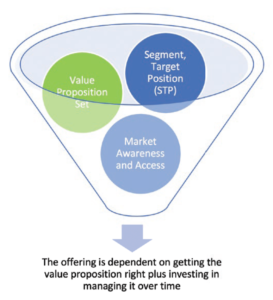Much of the exposure that is faced by corporations, small to large, is at the core. Yes, you are often blind sided by the fact that your combination of value propositions may not resonate as well as they once did. The markets are increasingly more dynamic.
Some of this is driven by competitors looking to one up and improve on your level of success. Time doesn’t stand still and not truer said today that at any time in the annals of business. It used to be that in B2B a new product would be launched, and it would perform for 5-10 years with some minor adjustments. Today we’re dealing with change that’s more akin to women’s fashion. This build up is all about your need to effectively assess and manage your value propositions.
Less than 10% of companies really stress test their value propositional layers effectively. To do so one must be committed to assess the strength and relevancy, at least once per year. By saying value proposition, we don’t just mean one proposition, as you have many products and services, plus that of your corporate brand. Each unit of your business does need to be dissected and looked at versus alternatives. You need to understand how well your value proposition set resonates vs. alternatives. A well-done paper published by the Harvard Business Review over a decade ago, March 2006, called “Customer Value Propositions in Business Markets” by James C. Anderson, James A Narus and Wouter Van Roussum, describe the most effective ways to establish your value proposition.
 Favorable Points of Difference — these are the areas to strive for, as they create separation and help drive value to the degree that they resonate with customers. The favorable points of difference of a market offering is compared to what it has is relative to the next best alternative. In comparing the iPhone vs. the Android, what are the favorable points of difference for business users. As we’re aware the delta in uniqueness has been reduced in the smart phone business.
Favorable Points of Difference — these are the areas to strive for, as they create separation and help drive value to the degree that they resonate with customers. The favorable points of difference of a market offering is compared to what it has is relative to the next best alternative. In comparing the iPhone vs. the Android, what are the favorable points of difference for business users. As we’re aware the delta in uniqueness has been reduced in the smart phone business.
Points of Parity/All Benefits — this represents the pool of attributes we commonly refer to as value propositions. The various other alternatives vying for your customers business may also have the same in perceived equivalent value. So, unless you can substantiate a clear differentiation, it’s a point of parity. Stressing a point of parity in what customers may mistakenly presume to be a point of difference that favors a competitor offering, can be one of the most important parts of constructing an effective value proposition.
Resonating Focus — These are the one or two points of difference whose improvement will deliver the greatest value to the customer target for the foreseeable future. The resonating focus could include a point or two of parity along with a favorable point of difference, so solidify the offering. These areas of focus can have different appeals based on the decision maker type/position. A contact in procurement vs. engineering vs. plant management or other will have varied resonating values. The offering must be tuned to the specific audience.
The value proposition set being well defined is an imperative as you apply the segment-target-position (STP) model. Marketing and advertising professionals frequently develop programs aimed at targets that are based on what they believe resonates and positions the product/service. What isn’t routine is getting the resonating focus correct by utilizing the value proposition analysis.
For the sake of your sales and execution strategy, it’s imperative that the value position work is assessed on a regular basis. Besides deciding to complete this work on several value propositions in play, it must be completed in an objective way and be stress-tested with representative customers. Contentment is never good and in the main, leads to a false sense of security about the business you lead.
 This truly is a blind side for most companies and their commercial teams. The value proposition is always being tested and challenged by competitors and events. There is no way to relax. The key is to be vigilant and key working and monitoring the value propositions success. In a football analogy, if the offensive line doesn’t hold up during a game/play, the quarterback will likely be disrupted and often blindsided. This affects the best design play, the most skilled players from having a chance. The sales channels depend on effective marketing to include value proposition resonation. Sales professionals like football athletes can execute more readily if they are put in position for success.
This truly is a blind side for most companies and their commercial teams. The value proposition is always being tested and challenged by competitors and events. There is no way to relax. The key is to be vigilant and key working and monitoring the value propositions success. In a football analogy, if the offensive line doesn’t hold up during a game/play, the quarterback will likely be disrupted and often blindsided. This affects the best design play, the most skilled players from having a chance. The sales channels depend on effective marketing to include value proposition resonation. Sales professionals like football athletes can execute more readily if they are put in position for success.
We suggest you complete this at the very least two levels, one on your company and the second on your key products/services. It’s often easy to conflate your product and your company’s image/brand into one resonating focus proposition.
As an example, Steve Jobs of Apple is famous for his legacy of design. He also focused on greatness vs. bigness. These aspirations showed up in many ways in Apple products then and still do today, to a degree.
Many developers and customers were drawn to this attribute of Apple and it resonated effectively at the top level and in the products and services offered by Apple. While he was famous for his disdain of market research, he did deploy research techniques like ethnography to better understand his customers situations.
A good activity is building a value proposition matrix of all your and your next best alternatives (could be 2-5 competitors as strengths vary by each) by the various attributes that your products and services offer plus those of competitors. This can be worked per the levels above. There are several ways to support the development of a matrix and converting points of value. Here’s some of them:
- Customer input — can be conducted internally or with a consultant/external researcher. It must be done without injecting bias and listing those attributes/features that customers volunteer. A background document of information can be provided ahead as prereading to support this exercise is acceptable.
- Internal exercise — for selected group marketing and sales team members a list can be assembled into a matrix and scored. It can be combined with those from customers to assess what resonates.
- Innovation and offering development team input — we often take the well vetted list to the innovation team. This is often employed to engage the development team and when there’s a need to create more separation with other alternatives in the space. The innovation normally focuses on newer generation of products based on science, approaches and new technologies that are in play like IoT, new sensor, functional medicine, distributed workforces, VR-AI-Bioelectronic wearables, etc. What make the innovation exercise invaluable (provided its well vetted prior to the session) is that the science and ideas based team visually see the gaps between your company and other alternatives. And much of these gaps, are a surprise to them.


